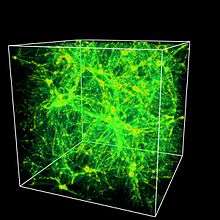Warm–hot intergalactic medium
The warm–hot intergalactic medium (WHIM) is the sparse, warm-to-hot (105 to 107 K) plasma that cosmologists believe to exist in the spaces between galaxies and to contain 40–50%[1][2] of the baryonic 'normal matter' in the universe at the current epoch.[3] The WHIM can be described as a web of hot, diffuse gas stretching between galaxies, and consists of plasma or as atoms and molecules, in contrast to dark matter. The WHIM is a proposed solution to the missing baryon problem, where the observed amount of baryonic matter does not match theoretical predictions from cosmology.[4]

Much of what is known about the warm–hot intergalactic medium comes from computer simulations of the cosmos.[5] The WHIM is expected to form a filamentary structure of tenuous, highly ionized baryons with a density of 1−10 particles per cubic meter.[6] Within the WHIM, gas shocks are created as a result of active galactic nuclei, along with the gravitationally-driven processes of merging and accretion. Part of the gravitational energy supplied by these effects is converted into thermal emissions of the matter by collisionless shock heating.[1]
Because of the high temperature of the medium, the expectation is that it is most easily observed from the absorption or emission of ultraviolet and low energy X-ray radiation. To locate the WHIM, researchers examined X-ray observations of a rapidly growing supermassive black hole known as an active galactic nucleus, or AGN. Oxygen atoms in the WHIM were seen to absorb X-rays passing through the medium.[7] In May 2010 a giant reservoir of WHIM was detected by the Chandra X-ray Observatory lying along the wall-shaped structure of galaxies (Sculptor Wall) some 400 million light-years from Earth.[7][8] In 2018, observations of highly-ionized extragalactic oxygen atoms appeared to confirm simulations of the WHIM mass distribution.[4]
See also
| Look up warm-hot intergalactic medium in Wiktionary, the free dictionary. |
- Intergalactic space
- Intracluster medium
References
- Bykov, A. M.; et al. (February 2008), "Equilibration Processes in the Warm-Hot Intergalactic Medium", Space Science Reviews, 134 (1–4): 141–153, arXiv:0801.1008, Bibcode:2008SSRv..134..141B, doi:10.1007/s11214-008-9309-4.
- Moskvitch, Katia (16 September 2018). "Astronomers Have Found The Universe's Missing Matter - For decades, some of the atomic matter in the universe had not been located. Recent papers reveal where it's been hiding". Wired. Retrieved 16 September 2018.
- Reimers, D. (2002), "Baryons in the diffuse intergalactic medium", Space Science Reviews, 100 (1/4): 89, Bibcode:2002SSRv..100...89R, doi:10.1023/A:1015861926654
- Nicastro, F.; et al. (June 2018), "Observations of the missing baryons in the warm-hot intergalactic medium", Nature, 558 (7710): 406–409, arXiv:1806.08395, Bibcode:2018Natur.558..406N, doi:10.1038/s41586-018-0204-1.
- Ryden, Barbara; Pogge, Richard (June 2016), Interstellar and Intergalactic Medium, Ohio State Graduate Astrophysics Series, The Ohio State University, pp. 240−244, ISBN 978-1-914602-02-7CS1 maint: ignored ISBN errors (link)
- Nicastro, Fabrizio; et al. (January 2008). "Missing Baryons and the Warm-Hot Intergalactic Medium". Science. 319 (5859): 55. arXiv:0712.2375. Bibcode:2008Sci...319...55N. doi:10.1126/science.1151400.
- "Huge Chunk of Universe's Missing Matter Found". Space.com. Retrieved 2016-12-05.
- "Last "Missing" Normal Matter Is Found - Sky & Telescope". 14 May 2010.